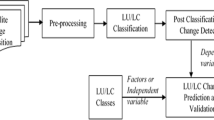Abstract
Numerous environmental issues are being faced by the world today as a result of unfavorable climate changes brought on by global warming and other man-made factors, as well as natural earth imbalances. Consequently, the temperature is rising every day, and as a result of the melting of land, snow, or ice sheets, the world's sea levels are rising. One of the largest difficulties we have is the rising rates of melting of land-based snow and ice sheets, which we must regulate or address as soon as feasible. So, utilizing a few digital image processing techniques and a few other geospatial techniques applied to high resolution snow-covered satellite photos, an effort is made in this work to research and build a system that can extract the snow-covered area using K-means clustering. Using temporal satellite imageries, this work went further to investigate and comprehend changes in snow-covered Himalayan ranges from the years 1984 to 2022.





Similar content being viewed by others
Data availability
Not applicable.
References
Akca S, Polat N (2022) Semantic segmentation and quantification of trees in an orchard using UAV orthophoto. Earth Sci Inform 15:2265–2274. https://doi.org/10.1007/s12145-022-00871-y
He G et al (2015) Extracting snow cover in mountain areas based on SAR and optical data. IEEE Geosci Remote Sens Lett 12(5):1136–1140
Hiremath PS, Kodge BG (2010) Automatic open space area extraction and change detection from high resolution urban satellite images. IJCA,Special Issue on RTIPPR (2):76–82
https://bhuvan.nrsc.gov.in. Accessed 15 Aug 2023
https://docs.qgis.org/3.16/en/docs/user_manual/index.html. Accessed 15 Aug 2023
https://earth.google.com/web/data. Accessed 15 Aug 2023
https://livingatlas2.arcgis.com/eoexplorer/. Accessed 15 Aug 2023
https://www.esri.com/en-us/arcgis/products/imagery-remote-sensing/. Accessed 15 Aug 2023
https://www.iirs.gov.in/iirs/sites/default/files/upload/document/Long-Term_SCA_Mapping.pdf. Accessed 15 Aug 2023
Hu M, Zhou G, Lv X, Zhou L, He X, Tian Z (2022) A New Automatic Extraction Method for Glaciers on the Tibetan Plateau under Clouds. Shadows Snow Cover Remote Sens 14:3084. https://doi.org/10.3390/rs14133084
Huang Y, Song Z, Yang H, Yu B, Liu H, Che T, Chen J, Wu J, Shu S, Peng X, Zheng Z, Xu J (2022) Snow cover detection in mid-latitude mountainous and polar regions using nighttime light data. Remote Sens Environ 268. https://doi.org/10.1016/j.rse.2021.112766
Lee S, Choi J (2022) A snow cover mapping algorithm based on a multitemporal dataset for GK-2A imagery. GIScience Remote Sens 59(1):1078–1102. https://doi.org/10.1080/15481603.2022.2097395
Liu Z et al (2008) The extraction of snow cover information based on MODIS data and spatial modeler tool, 2008 International Workshop on Education Technology and Training & 2008. Int Work Geosci Remote Sens 2008:836–839. https://doi.org/10.1109/ETTandGRS.2008.252
Liu C, Huang X, Li X, Liang T (2020) MODIS Fractional Snow Cover Mapping Using Machine Learning Technology in a Mountainous Area. Remote Sens 12:962
Liu Y, Chen X, Hao JS et al (2020) Snow cover estimation from MODIS and Sentinel-1 SAR data using machine learning algorithms in the western part of the Tianshan Mountains. J Mt Sci 17:884–897. https://doi.org/10.1007/s11629-019-5723-1
Lv Z, Liu T, Shi C, Benediktsson JA, Du H (2019) Novel Land Cover Change Detection Method Based on k-Means Clustering and Adaptive Majority Voting Using Bitemporal Remote Sensing Images. IEEE Access 7:34425–34437. https://doi.org/10.1109/ACCESS.2019.2892648
Zhang J, Jia L, Menenti M, Zhou J, Ren S (2021) Glacier Area and Snow Cover Changes in the Range System Surrounding Tarim from 2000 to 2020 Using Google Earth Engine. Remote Sens 13:5117. https://doi.org/10.3390/rs13245117
Acknowledgements
I am very much grateful to Google, ESRI and Bhuvan (ISRO) for providing primary data (high resolution satellite images) for this study. Similarly, I am also thankful to QGIS team for providing such a great tool for geo-spatial research and development.
Funding
No funding is used for this work.
Author information
Authors and Affiliations
Contributions
The presented work deals with some digital image processing, geo-informatic tools and K-Means clustering like techniques to extract the snow covered area from high resolution satellite imageries. Further the work is extended to do a comparative analysis of extracted snow covered areas from time series satellite images (1984-2022) of Himalayan ranges.
Corresponding author
Ethics declarations
Competing interests
The authors declare no competing interests.
Conflict of interest
Being an author I declare that, I have no known competing financial interests or personal relationships that could have appeared to influence the work reported in this paper.
Additional information
Communicated by: H. Babaie
Publisher's note
Springer Nature remains neutral with regard to jurisdictional claims in published maps and institutional affiliations.
Rights and permissions
Springer Nature or its licensor (e.g. a society or other partner) holds exclusive rights to this article under a publishing agreement with the author(s) or other rightsholder(s); author self-archiving of the accepted manuscript version of this article is solely governed by the terms of such publishing agreement and applicable law.
About this article
Cite this article
Kodge, B.G. Extraction and analysis of snow covered area from high resolution satellite imageries using K-means clustering. Earth Sci Inform 16, 4285–4291 (2023). https://doi.org/10.1007/s12145-023-01108-2
Received:
Accepted:
Published:
Issue Date:
DOI: https://doi.org/10.1007/s12145-023-01108-2




